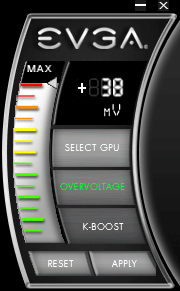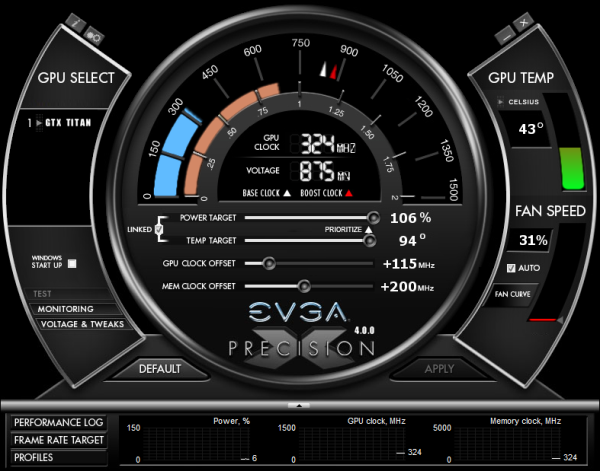NVIDIA’s GeForce GTX Titan Review, Part 2: Titan's Performance Unveiled
by Ryan Smith & Rahul Garg on February 21, 2013 9:00 AM ESTThe Final Word On Overclocking
Before we jump into our performance breakdown, I wanted to take a few minutes to write a bit of a feature follow-up to our overclocking coverage from Tuesday. Since we couldn’t reveal performance numbers at the time – and quite honestly we hadn’t even finished evaluating Titan – we couldn’t give you the complete story on Titan. So some clarification is in order.
On Tuesday we discussed how Titan reintroduces overvolting for NVIDIA products, but now with additional details from NVIDIA along with our own performance data we have the complete picture, and overclockers will want to pay close attention. NVIDIA may be reintroducing overvolting, but it may not be quite what many of us were first thinking.
First and foremost, Titan still has a hard TDP limit, just like GTX 680 cards. Titan cannot and will not cross this limit, as it’s built into the firmware of the card and essentially enforced by NVIDIA through their agreements with their partners. This TDP limit is 106% of Titan’s base TDP of 250W, or 265W. No matter what you throw at Titan or how you cool it, it will not let itself pull more than 265W sustained.
Compared to the GTX 680 this is both good news and bad news. The good news is that with NVIDIA having done away with the pesky concept of target power versus TDP, the entire process is much simpler; the power target will tell you exactly what the card will pull up to on a percentage basis, with no need to know about their separate power targets or their importance. Furthermore with the ability to focus just on just TDP, NVIDIA didn’t set their power limits on Titan nearly as conservatively as they did on GTX 680.
The bad news is that while GTX 680 shipped with a max power target of 132%, Titan is again only 106%. Once you do hit that TDP limit you only have 6% (15W) more to go, and that’s it. Titan essentially has more headroom out of the box, but it will have less headroom for making adjustments. So hardcore overclockers dreaming of slamming 400W through Titan will come away disappointed, though it goes without saying that Titan’s power delivery system was never designed for that in the first place. All indications are that NVIDIA built Titan’s power delivery system for around 265W, and that’s exactly what buyers will get.
Second, let’s talk about overvolting. What we didn’t realize on Tuesday but realize now is that overvolting as implemented in Titan is not overvolting in the traditional sense, and practically speaking I doubt too many hardcore overclockers will even recognize it as overvolting. What we mean by this is that overvolting was not implemented as a direct control system as it was on past generation cards, or even the NVIDIA-nixed cards like the MSI Lightning or EVGA Classified.
Overvolting is instead a set of two additional turbo clock bins, above and beyond Titan’s default top bin. On our sample the top bin is 1.1625v, which corresponds to a 992MHz core clock. Overvolting Titan to 1.2 means unlocking two more bins: 1006MHz @ 1.175v, and 1019MHz @ 1.2v. Or put another way, overvolting on Titan involves unlocking only another 27MHz in performance.

These two bins are in the strictest sense overvolting – NVIDIA doesn’t believe voltages over 1.1625v on Titan will meet their longevity standards, so using them is still very much going to reduce the lifespan of a Titan card – but it’s probably not the kind of direct control overvolting hardcore overclockers were expecting. The end result is that with Titan there’s simply no option to slap on another 0.05v – 0.1v in order to squeak out another 100MHz or so. You can trade longevity for the potential to get another 27MHz, but that’s it.
Ultimately, this means that overvolting as implemented on Titan cannot be used to improve the clockspeeds attainable through the use of the offset clock functionality NVIDIA provides. In the case of our sample it peters out after +115MHz offset without overvolting, and it peters out after +115MHz offset with overvolting. The only difference is that we gain access to a further 27MHz when we have the thermal and power headroom available to hit the necessary bins.
| GeForce GTX Titan Clockspeed Bins | |||
| Clockspeed | Voltage | ||
| 1019MHz | 1.2v | ||
| 1006MHz | 1.175v | ||
| 992MHz | 1.1625v | ||
| 979MHz | 1.15v | ||
| 966MHz | 1.137v | ||
| 953MHz | 1.125v | ||
| 940MHz | 1.112v | ||
| 927MHz | 1.1v | ||
| 914MHz | 1.087v | ||
| 901MHz | 1.075v | ||
| 888MHz | 1.062v | ||
| 875MHz | 1.05v | ||
| 862MHz | 1.037v | ||
| 849MHz | 1.025v | ||
| 836MHz | 1.012v | ||
Finally, as with the GTX 680 and GTX 690, NVIDIA will be keeping tight control over what Asus, EVGA, and their other partners release. Those partners will have the option to release Titan cards with factory overclocks and Titan cards with different coolers (i.e. water blocks), but they won’t be able to expose direct voltage control or ship parts with higher voltages. Nor for that matter will they be able to create Titan cards with significantly different designs (i.e. more VRM phases); every Titan card will be a variant on the reference design.
This is essentially no different than how the GTX 690 was handled, but I think it’s something that’s important to note before anyone with dreams of big overclocks throws down $999 on a Titan card. To be clear, GPU Boost 2.0 is a significant improvement in the entire power/thermal management process compared to GPU Boost 1.0, and this kind of control means that no one needs to be concerned with blowing up their video card (accidentally or otherwise), but it’s a system that comes with gains and losses. So overclockers will want to pay close attention to what they’re getting into with GPU Boost 2.0 and Titan, and what they can and cannot do with the card.











337 Comments
View All Comments
Tetracycloide - Thursday, February 21, 2013 - link
That's the thing, it's not a 'consumer gaming card.' It's a consumer compute card. Obviously the price for performance for gaming makes no sense but that's not their target market.ronin22 - Thursday, February 21, 2013 - link
This exactly!It's an amazing card for computing.
I wish I could get one...
Blazorthon - Thursday, February 21, 2013 - link
In reply to both of your comments, I have to ask this: If that is justification for its price, then why is it that AMD doesn't have their Tahiti cards priced like that and why didn't Nvidia price their previous consumer compute cards like that (GTX 280, GTX 285, GTX 480, GTX 580, etc.)?CommandoCATS - Friday, February 22, 2013 - link
Because this seems like a specialized thing for people who care about compute tasks within NVidia's CUDA universe (and things like iRay, which didn't exist when previous generations first came out).The truth is that in academia and research, CUDA is still the top dog (just do a google scholar search). I'm sure for most gamers, the GTX 680 is the way better deal. However, this is essentially a Tesla K20 for 1/3rd of the cost, so it's kind of a bargain from that perspective.
cheersloss - Saturday, February 23, 2013 - link
Exactly right. There is nothing about this card that is a value. The same compute functions were there in the older flagships as well, the gtx 580, 480, 280 etc.Titan is just an overpriced, overhyped trainwreck. Another attempt at a cashgrab on the gullible.
CeriseCogburn - Saturday, February 23, 2013 - link
The gullible that have the several thousands of extra they can spend that you don't have and cannot spend.Certainly poorboy feels better after having called his superiors gullible. The jelly is seeping through at an extraordinary rate.
cheersloss - Saturday, February 23, 2013 - link
Exactly right. There is nothing about this card that is a value. The same compute functions were there in the older flagships as well, the gtx 580, 480, 280 etc.Titan is just an overpriced, overhyped trainwreck. Another attempt at a cashgrab on the gullible.
CeriseCogburn - Saturday, February 23, 2013 - link
LOLGood you run the 280, and I'll run the Titan, and we can be equal and best friends, and I'll tell you over and over all the benchmarks and games and fps scores and compute tests are lying and your 280 is just as good and the same and you're right and I wish so badly that I was as poor as you and just bought a used 3 gen back nVidia card, but they fooled me, the gullible gamer.
CeriseCogburn - Tuesday, February 26, 2013 - link
ROFL - aww poor baby, now tessellation and compute is a total loss for amd, too as you conveniently forgot to include the 680, 670 660Ti 660 650Ti 650. hahahahha u people suck.So I can buy 2 amd cards that crash and don't run CF at all 33% of the time, or I can buy the most awesome top card in the entire world of gaming and play all the titles and be just great, or I can buy 2 nVidia cards and SLI them and have every game run except correctly except 1 while amd CF fails often...
I can buy the most stable, fully featured, many more featured nVidia card, or I can buy the dying no catalyst driver writers worth their salt (fired for savings) or left for better waters or headhunted, crashing piece of rotten unsupported glitching amd crap.
$999 looks like a bargain basement price to me. I can hardly wait to own The Shield, too.
Innovation. Awesomeness. New features. Unified drivers THAT JUST WORK.
Features ported BACKWARDS to prior generations.
Cuda
PhysX
Frame Rate Target
Boost
Stable dual card setups
Same game day drivers
Honest company not cheating liars like amd
I BUILT THIS co-founder Jen-Hsun Huang current CEO, a perfect example of the awesomeness of capitalism and personal success and the American Dream in REAL LIFE. lol
( Oh I bet those little OWS activist amd fanboys we have here are shooting blood through every pore)
Why in the world would I buy an amd card ? There's only one reason - to try to save a dying loser in a kind act of CHARITY - and frankly, what we have for amd fanboys is nothing short of the most evil little penny pinching crying whining baby SCROOGES I have ever seen.
So we can FORGET IT when it comes to the amd fanboy rabble here supporting AMD - they support only their own selfish fanboy agenda and psychotic public pocketbook panhandling.
I'd like to thank TheJian for pointing out amd fail coverage, vs the ignoring of the nVidia FINANCIAL SUCCESS STORY:
amd Q earnings coverage
"
http://www.anandtech.com/show/5465/amd-q411-fy-201...
http://www.anandtech.com/show/5764/amd-q112-earnin...
http://www.anandtech.com/show/6383/amd-q3-2012-ear...
http://www.anandtech.com/show/6690/amd-q412-and-fy...
"
nVidia Q earnings coverage
http://www.anandtech.com/show/6746/tegra-4-shipmen...
LOL - let it burn you crybabies to the CORE, I hope blood shoots from your eyes...
xaml - Sunday, March 3, 2013 - link
Don't leave out the biggest "crybaby" of all, yourself.